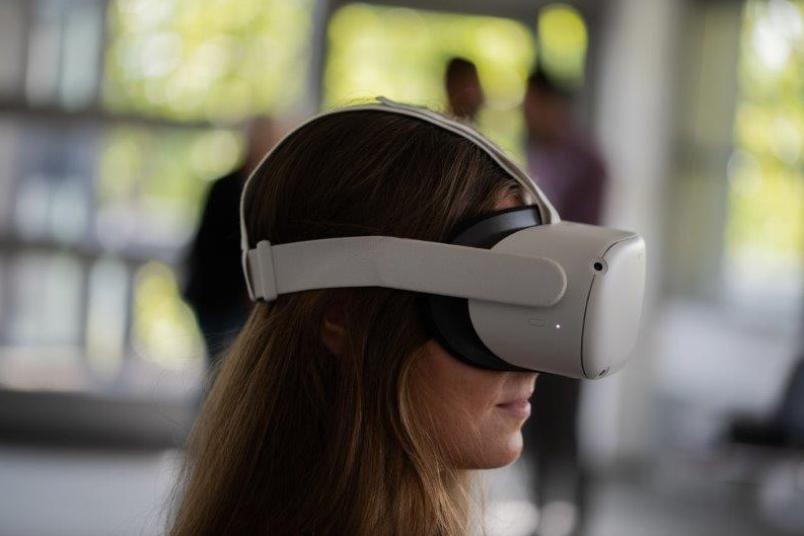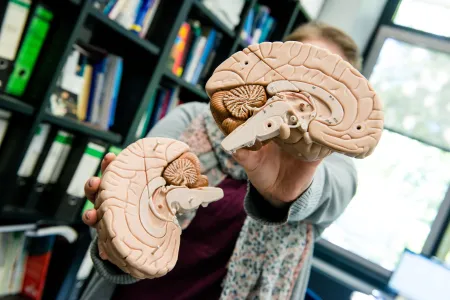
NEUROSCIENCE
When we feel things that are not there
The discovery of the phantom touch illusion provides insights into human perception and opens up new perspectives for interaction with virtual reality technology.
Virtual reality (VR) is not only a technology for games and entertainment, but also has potential in science and medicine. Researchers at Ruhr University Bochum, Germany, have now gained new insights into human perception with the help of VR. They used virtual reality scenarios in which subjects touched their own bodies with a virtual object. To the researchers’ surprise, this led to a tingling sensation at the spot where the avatarized body was touched. This effect occurred even though there was no real physical contact between the virtual object and the body. The scientists led by Dr. Artur Pilacinski and Professor Christian Klaes from the Department of Neurotechnology describe this phenomenon as a phantom touch illusion. They published their results in the journal “Scientific Reports” of the Nature Publishing Group in September 2023.
“People in virtual reality sometimes have the feeling that they are touching things, although they are actually only encountering virtual objects,” says first author Artur Pilacinski from the Knappschaftskrankenhaus Bochum Langendreer, University Clinic of Ruhr University Bochum, explaining the origin of the research question. “We show that the phantom touch illusion is described by most subjects as a tingling or prickling, electrifying sensation or as if the wind was passing through their hand.”
Body sensation arises from complex combination of different sensory perceptions
The neuroscientists wanted to understand what is behind this phenomenon and find out which processes in the brain and body play a role in it. They observed that the phantom touch illusion also occurred when the subjects touched parts of their bodies that were not visible in virtual reality. Second author Marita Metzler adds: “This suggests that human perception and body sensation are not only based on vision, but on a complex combination of many sensory perceptions and the internal representation of our body.”
This study involved 36 volunteers wearing VR glasses. First, they got used to the VR environment by moving around and touching virtual objects. Then they were given the task of touching their hand in the virtual environment with a virtual stick.
Comparison between virtual and suggested touch sensations
Participants were asked if they felt anything. If not, they were allowed to continue touching and the question was asked again later. If they felt sensations, they were asked to describe them and rate their intensity on different hand locations. This process was repeated for both hands. There was a consistent reporting of the sensation as “tingling” by a majority of participants.
In a control experiment, it was investigated whether similar sensations could also be perceived without visual contact with virtual objects purely due to experimental situation demands. Here, a small laser pointer was used instead of virtual objects to touch the hand. This control experiment did not result in phantom touch suggesting that phantom touch illusion was unique to virtual touch.
The discovery of the phantom touch illusion opens up new possibilities for further research into human perception and could also be applied in the fields of virtual reality and medicine. Christian Klaes, member of the Research Department of Neuroscience at Ruhr University, says: “It could even help to deepen the understanding of neurological diseases and disorders that affect the perception of one’s own body.”
Further collaboration with the University of Sussex
The Bochum team plans to continue their research on the phantom touch illusion and the underlying processes. For this reason, a collaboration with the University of Sussex has been started. “It is important to first distinguish between the actual sensations of phantom touch and other cognitive processes that may be involved in reporting such embodied sensations, such as suggestion, or experimental situation demands,” says Artur Pilacinski. “We also want to further explore and understand the neural basis of the phantom touch illusion in collaboration with other partners.”
The research of Artur Pilacinski and Christian Klaes took place within the Research Department of Neuroscience (RDN). The RDN further develops and consolidates a long-established, outstanding research strength of Ruhr University Bochum in the field of systems neuroscience research.
